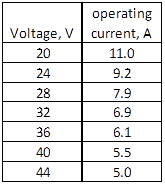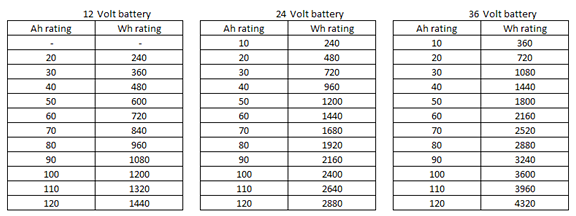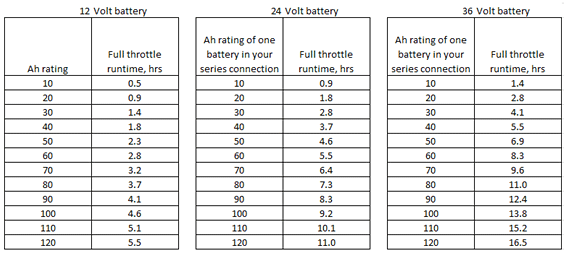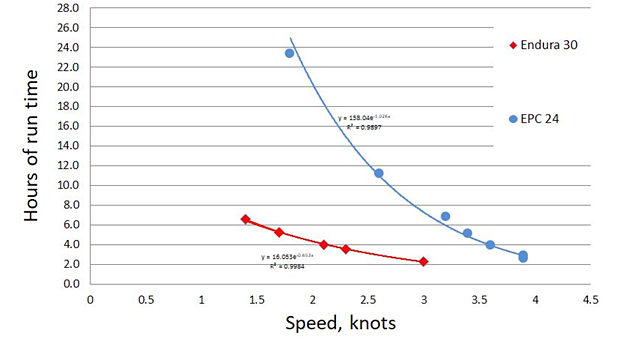Blogpost by Founder Joe Grez November 2023
EP Carry Integrated systems are sold with a non-proprietary 24V Lithium Iron Phosphate battery manufactured by K2 Energy Solutions. However, EP Carry was designed to allow Battery choice rather than limit customers to a proprietary battery type. EP Carry's electronics automatically adapt to a wide range of battery sources. EP Carry's operational input voltage range is between 20V and 45V. The maximum fully-charged voltage of a 36V lithium battery can be as high as 43.5V which is close to the maximum input voltage for EP Carry. So when choosing a battery based on its nominal designation, 36V is the highest that should be used. Under 20V, EP Carry will not attain its full rated power. For 12V operation, we offer an optional boost converter– see our online store.
This selection guide has three sections: Battery types, current capability, and range estimation.
EP Carry supports the use of any battery chemistry but the most common are lead-acid and lithium. Both lead-acid and Lithium batteries are further separated in two types; deep cycle or starting. For marine propulsion, and when using lead-based batteries, you will have satisfying performance only with deep cycle types. A deep cycle battery is rated by Amp hours (Ah) and a starting battery is rated by peak amp ratings (A), also called CCA (cold-cranking Amps). The Ah rating is what matters for an electric outboard and the CCA rating is immaterial to the application.
Appropriately sized lithium batteries are suitable for deep cycle applications unless rated by "equivalent Ah", which refers to the equivalent energy capacity of a lead-acid battery that can supply the same CCA peak current. When listed, the "equivalent Ah" rating is generally ˜ 1/10th of a battery's actual capacity so be sure to choose a lithium battery with an Ah rating that is not accompanied by modifying words like "equivalent" on the label.
Sealed lead-acid batteries are a familiar choice. They are simple too- containing no electronics, internal protections or regulation. They are less expensive to purchase but they can be more expensive to own over the long run. They are also heavy and the most inefficient battery type. If you are charging using solar, you can generally get away with a 30% smaller lithium battery vs a lead-acid type for the same range. For all lead acid-types, you will need to add a 40A fuse for safety. We do not recommend flooded lead acid batteries on a small boat due to the risk of acid leakage.
Lithium is now the standard in the propulsion industry but there are several types of lithium batteries to consider. The most common are Lithium polymer (lipo) and Lithium Iron Phosphate (LFePO4). Lipo batteries are less expensive, lighter and smaller for the same capacity, but not as long-lived as LiFePO4. The standard EP Carry battery is the less energy-dense but longer-lived LiFePO4 type. Most LiFePo4 battery manufacturers claim 2000 or more discharge cycles before the battery degrades to 80% of its initial capacity. EP Carry Lithium batteries sold in 2017 are still measuring well over 80% of their initial capacity.
All Lithium batteries must have internal over temp, over current, over voltage and under voltage protections as well as cell balancing built in. These protections are easy to advertise and hard to verify so we strongly recommend staying away from discount off-brand lithium batteries. While a well-engineered and well-constructed lithium pack is 100% safe, I would not trust my family’s safety to off-brand lithium products from companies that take no responsibility for safety or performance once a battery is sold.
For EP Carry applications, if the pack's advertised internal current protection is higher than 40 amps, add a 40 Amp fuse or fast-acting breaker for safety.
Waterproof is a must for any lithium battery on a boat. Unfortunately, few battery manufacturers list an IP rating for their products so unless you do internal testing like we did for our K2 batteries, house your Lithium batteries in a dry bag or sealed enclosure. Unlike lead-acid or NiMH batteries, Lithium types do not need to vent during normal charging, discharging or storage.
The second thing to consider when making a battery choice is its maximum power draw. A standard EP Carry draws 220W max. Because batteries are not as commonly rated by their power (Watts) we’ll stick to convention and state max constant amperage draw ratings. We recommend batteries with max constant current ratings as follows.

You want to choose a battery that will give you the required range. Estimating range is a three-step process.
In the following example, we use nautical miles but the calculation is the same for statute miles and km. Just be sure to use mph when calculating miles and km/h when using kilometers. Here we go:
The first step is to determine the Wh rating of your battery. You can calculate this by multiplying your battery voltage rating by its Ah rating or by using the tables below.

The next step is to calculate the hours of runtime by dividing the Wh capacity of your battery by the input power to the motor. For example, a battery with 720Wh of capacity divided by the 220W max power input to an EP Carry produces 3.3 hours of run time. Below are tables of calculations if you prefer.

The final step is to calculate range. This is equal to boat speed multiplied by the run time.
For example, if your boat goes 4 knots at full throttle and you have 3.3 hrs of runtime, then: 3.3 hr x 4 knots = 13.2 nm of range when using full throttle.
It is good practice to do sea trials when you get your EP Carry. Take note of your speed at full throttle, ½ throttle, and ¼ throttle in a waterway with no current. For quick reference, you can create your own table of ranges at various throttle settings.
12V EP Carry performance vs. a trolling motor:
If you're used to the performance of a trolling motor, here's a range and speed comparison of an EP Carry vs a Minn Kota Endura 30. This tiny trolling motor was chosen for comparison because it has the closest max input electrical power vs EP Carry. However, at the same speeds, EP Carry provides between 3x and 6x the range using the same battery. The EP Carry goes a full knot faster while still using less input power. An efficient motor like EP Carry allows you to gain more speed and range without switching to a larger, heavier, and more expensive battery and charger.
EP Carry vs Endura 30, both using a Dakota 54Ah 12V battery, measured driving a 9' Minto dinghy, 400 lb total displacement.

Note the EP Carry requires the use of our optional 12V boost converter to run from this 12V battery.